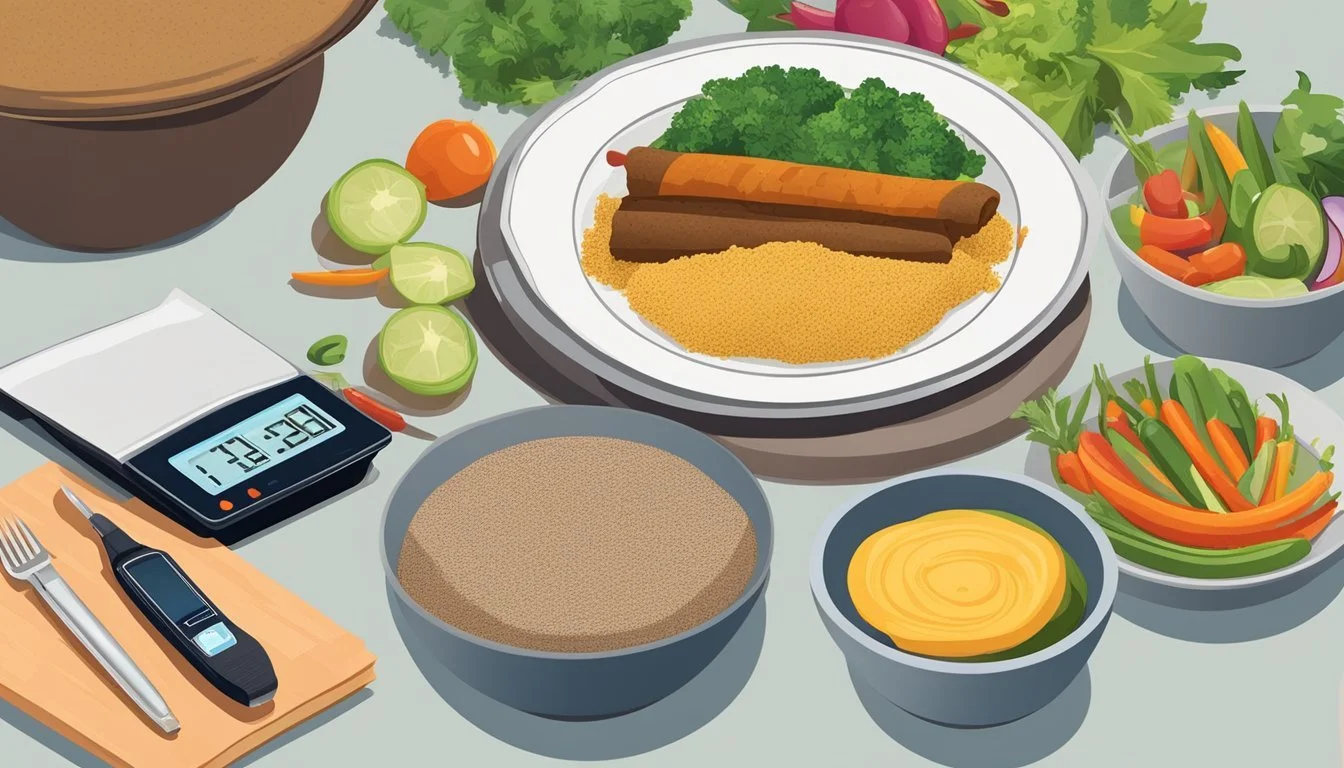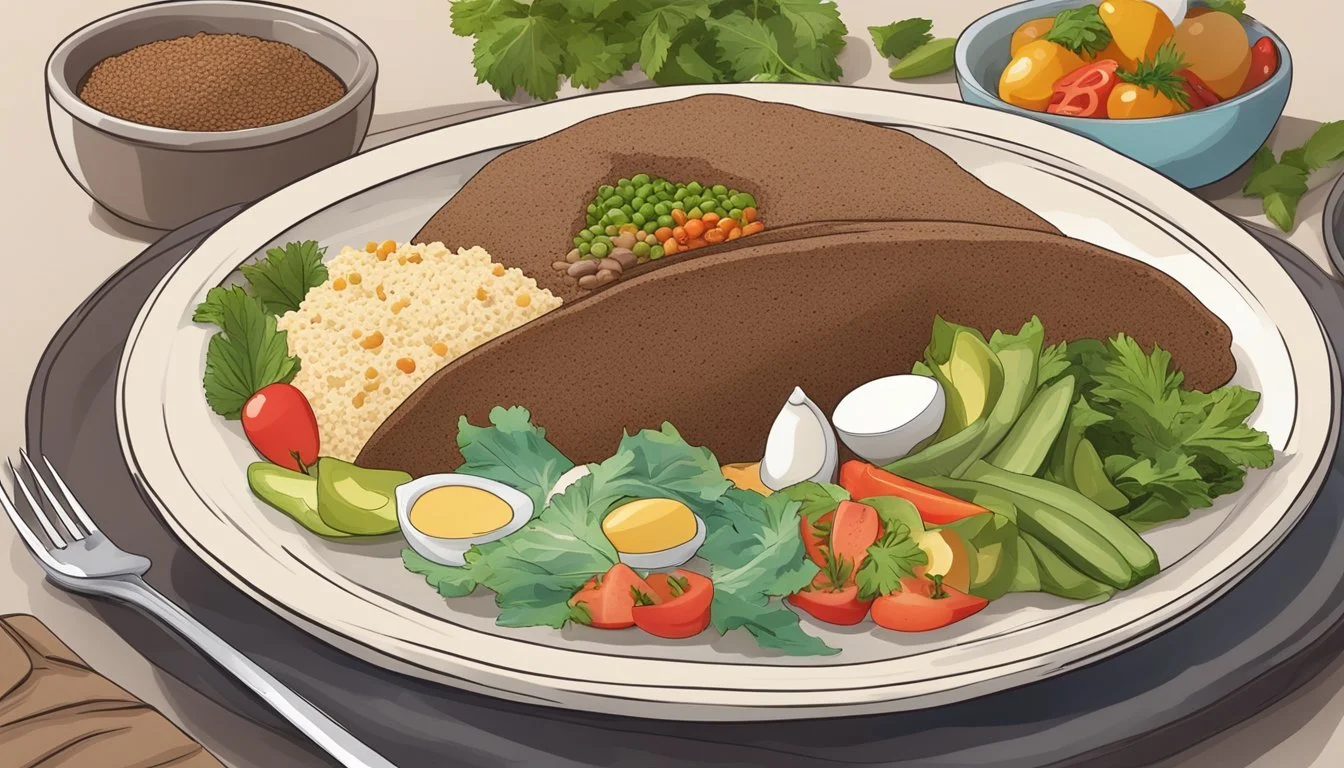Can Diabetics Eat Injera?
Understanding the Nutritional Impact
Injera, the traditional Ethiopian flatbread made from teff flour, has garnered attention for its potential benefits for individuals with diabetes. Described as a thick variety of South Indian Dosa, injera is made from fermented dough, contributing to its unique texture and mild sour flavor. Many wonder if this staple can be safely incorporated into a diabetic diet.
Yes, diabetics can eat injera, but it is crucial to manage portion sizes due to its carbohydrate content. Studies indicate that teff, the primary ingredient in injera, has a relatively low glycemic index (GI) compared to other grains, making it a safer choice for those managing blood sugar levels. However, overconsumption can still lead to spikes in blood sugar, stressing the importance of moderation.
Besides its lower GI, teff is rich in essential nutrients such as iron, calcium, and fiber, making injera a nutritious option. This is particularly important for diabetics who need a balanced intake of vitamins and minerals. By integrating injera thoughtfully and monitoring portions, diabetics can enjoy this flavorful bread while keeping their glucose levels in check.
Understanding Diabetes and Dietary Needs
Diabetes is a condition where the body struggles to regulate blood glucose levels. This often stems from issues with insulin production or function. Insulin is crucial for moving glucose from the bloodstream into cells for energy.
People with diabetes need to manage their carbohydrate intake carefully. Carbs affect blood sugar levels, so understanding the glycemic index (GI) and glycemic load (GL) of foods is important.
Glycemic Index measures how quickly a food raises blood glucose. Glycemic Load considers both the GI and the carb content. Foods with low GI and GL are better for blood sugar control.
Key Dietary Needs:
Monitor Carbohydrates: Essential for managing blood glucose. Consume complex carbs that are digested slowly.
Balanced Nutrition: A diet with adequate proteins, healthy fats, and fiber can improve metabolic health.
Limit High GI Foods: These can cause spikes in blood sugar levels.
Consider Heart Health: Diabetes increases the risk of heart disease. Focus on foods that support heart health, like high-fiber options and those low in saturated fats.
Important Nutrients:
Fiber: Helps regulate blood sugar and cholesterol levels.
Proteins: Vital for muscle health and satiety.
Healthy Fats: Support heart health, found in nuts, seeds, and fish.
Tools for Management:
Portion Control: Using the plate method can help with balanced meals.
Regular Monitoring: Checking blood glucose levels frequently helps in making dietary adjustments.
Consultation: Working with a dietitian to tailor dietary plans can be beneficial.
A balanced diet that maintains steady blood sugar levels, lowers A1C, and supports overall health is key for people with diabetes.
The Nutrition Profile of Injera
Injera, a staple in Ethiopian cuisine, is not only known for its unique taste and texture but also for its nutritional benefits, particularly for diabetics. Key points to consider are its core ingredient, teff, its macronutrient composition, and its glycemic index and load.
Teff: The Core Ingredient of Injera
Teff is a tiny grain that forms the basis of injera. Rich in nutrients, it is particularly notable for iron, calcium, and magnesium content.
Teff is gluten-free, making it a safe choice for those with celiac disease or gluten sensitivity.
It also contains all eight essential amino acids, providing a complete protein source. This makes injera a highly nutritious choice, especially for those looking to improve dietary intake of minerals and proteins.
Macronutrients in Injera
A single serving of injera provides a well-rounded macronutrient profile. It contains moderate amounts of protein and fat, with a higher emphasis on carbohydrates derived from the teff flour.
Fiber content in injera is significant, offering around 4.2 grams per serving. This high fiber content aids in digestion and promotes satiety, which can assist in weight management, essential for diabetics.
The sodium level stands at 868 milligrams per serving, contributing to daily intake limits, particularly important for those monitoring blood pressure.
Injera's Glycemic Index and Glycemic Load
Injera has a low glycemic index (GI) ranging between 35 to 55, which makes it a favorable option for controlling blood sugar levels. This low GI value is attributed to the slow digestion of carbohydrates in teff.
The glycemic load (GL) is also low, ensuring that blood sugar levels rise steadily rather than spiking dramatically. This property helps manage diabetes effectively.
The combination of these factors makes injera an excellent choice for diabetic patients seeking to maintain balanced blood glucose levels while enjoying diverse, flavorful foods.
Comparative Analysis of Injera and Other Staple Foods
Evaluating the suitability of Injera for diabetics necessitates comparing it with common staple foods to understand its nutritional profile and health implications. Important factors include glycemic index (GI), gluten content, and its place in both Ethiopian and Western diets.
Injera vs. Rice and Wheat Bread
Injera made from teff flour has a low glycemic index (GI of 35) compared to white wheat bread, which has a moderate GI of 57. Corn Injera has a slightly higher GI of 43.4 but is still considered low.
White rice, often a staple in many diets, typically has a higher GI ranging from 70 to 90, making it less suitable for diabetics. Wheat bread, while lower than rice, is still higher in GI compared to teff and corn Injera.
Comparison Table:
Food Glycemic Index (GI) Teff Injera 35 Corn Injera 43.4 White Wheat Bread 57 White Rice 70-90
The lower GI of Injera can lead to slower digestion and a more gradual rise in blood sugar levels, beneficial for diabetics.
Injera and Gluten Sensitivity
Injera, particularly made from teff, is naturally gluten-free, making it suitable for individuals with gluten sensitivity or celiac disease. Teff is an ancient grain and does not contain the gluten protein, unlike wheat.
In contrast, white wheat bread is rich in gluten, posing challenges for those with gluten intolerance. Corn Injera, often derived from maize, is also gluten-free and provides an alternative for those avoiding gluten.
Important Points:
Teff Injera: Gluten-free
Corn Injera: Gluten-free
White Wheat Bread: Contains gluten
Quinoa, another gluten-free grain, is sometimes compared to teff due to its similar nutritional benefits and suitability for gluten-sensitive diets.
Ethiopian Food Versus Western Diets
Ethiopian cuisine, including staple foods like Injera, features a variety of grains and legumes that are rich in nutrients and have lower glycemic indices. These foods often align well with dietary needs for managing diabetes.
Western diets, frequently high in processed foods, refined sugars, and high GI staples like white rice and white bread, pose challenges for diabetics. Whole grains, such as teff found in Injera, are less common in Western meals but offer substantial health benefits.
By including more whole grains like teff and opting for gluten-free options, those adhering to Western diets can better manage blood sugar levels and reduce gluten intake.
Health Benefits and Risks of Injera for Diabetics
Injera, a traditional Ethiopian flatbread made from teff, offers several health benefits but also comes with certain risks for diabetics. It is important to understand how injera impacts blood glucose control and heart health, while being aware of potential risks.
Blood Glucose Control
Injera, made from teff, has a low glycemic index (GI) ranging from 35 to 55 depending on its preparation. Foods with a low GI are beneficial for diabetics as they result in slower carbohydrate digestion and a steadier rise in blood glucose levels.
This is crucial for managing diabetes effectively. Teff is rich in fiber, which further helps in controlling blood sugar spikes. This insoluble fiber slows down the absorption of sugar and provides a feeling of fullness, potentially reducing overall caloric intake.
The glycemic load (GL) of injera is also considered low, making it a suitable choice for diabetics. Regular consumption can aid in maintaining balanced blood glucose levels, thus helping diabetics to manage their condition more sustainably.
Heart Health
Teff, the primary ingredient in injera, is a good source of omega-3 fatty acids and polyunsaturated fatty acids. These nutrients support heart health by reducing inflammation and lowering bad cholesterol (LDL) levels, which is crucial for diabetics who are at a higher risk of heart disease.
Fiber in teff further contributes to cardiovascular health by helping to lower cholesterol levels. Regular intake of fiber-rich foods like injera can lower blood pressure and improve overall heart function.
Maintaining heart health is essential for diabetics, as they are more prone to heart-related complications. Consuming injera can thus support cardiovascular well-being through its nutrient-rich profile.
Potential Risks
Though injera offers numerous benefits, there are potential risks for diabetics. Some variations, such as those made with corn, have a higher glycemic index and glycemic load, which can lead to undesirable blood sugar spikes.
Portion control is important as consuming injera in large quantities may lead to an excessive intake of carbohydrates, potentially disrupting blood glucose levels.
Additionally, not all injera is made using solely teff flour; sometimes, it includes other grains which may not have the same beneficial effects on blood sugar control. Diabetics should confirm the ingredients used and consult with healthcare providers to ensure injera fits into their dietary plan appropriately.
Incorporating Injera into a Diabetic Diet
Teff injera can be a nutritious addition to a diabetic diet if managed carefully. Attention to portion sizes, balanced meals, and individual health conditions can aid in maintaining stable blood glucose levels.
Portion Sizes and Frequency
Portion control is essential when consuming injera. Although teff injera has a lower glycemic index, large portions can spike blood glucose levels. Diabetics should limit their serving to one or two pieces per meal. Frequency of consumption should also be considered, ideally not more than a few times a week. Monitoring carbohydrate intake and adjusting portions based on daily dietary needs can help manage blood glucose and A1C levels effectively.
Balancing Injera with Other Foods
Pairing injera with a variety of foods is crucial. Vegetables, lean proteins (like tofu and beans), and healthy fats (like nuts) can create a balanced meal. Incorporating plenty of fiber from vegetables can slow carbohydrate digestion and absorption. Additionally, combining injera with dairy products like yogurt can provide essential nutrients and aid in maintaining satiety. It’s important to diversify the diet to ensure that diabetics get a broad spectrum of nutrients while managing their blood sugar levels.
Accounting for Individual Health Conditions
Individual health conditions must be considered when incorporating injera. Diabetics with a higher body mass index (BMI) may need to exercise more and consume smaller portions. Those with dietary restrictions should choose appropriate accompaniments to injera. Regular exercise plays a critical role in managing diabetes and should complement dietary choices. Consulting a healthcare provider can provide tailored advice, allowing for adjustments that accommodate an individual's unique health status and promote optimal glucose control.
Practical Tips for Enjoying Injera
Eating injera can be a healthy choice for diabetics due to its low glycemic index (GI). Incorporating certain techniques and ingredients can help in maintaining better blood sugar levels.
Recipe Adjustments for Lower GI
Choosing the Right Teff: Using 100% teff flour, which is high in dietary fiber, can help maintain its low GI properties.
Incorporating Sourdough Starter: Fermentation in the sourdough process can lower the GI further. It slows down the digestion and absorption of carbs, which is beneficial for blood sugar control.
Cooking Methods: Baking or cooking injera at a lower temperature can preserve its nutritional properties. Avoid adding sugar or high-GI grains.
Choosing Healthier Accompaniments
Healthy Proteins: Pair injera with protein-rich foods. Good choices are salmon, mackerel, sardines, or legumes. This helps in steady glucose absorption.
Healthy Fats: Include sources of healthy fats such as olive oil, avocado, and nuts. They add flavor and nutritional benefits.
Vegetables: Integrate a variety of non-starchy vegetables like leafy greens, bell peppers, and tomatoes. They are low in carbs yet high in fiber and essential nutrients.
Monitoring and Adjusting as Needed
Portion Control: Monitor portion sizes. Eating too much can spike blood sugar, even with low-GI foods.
Blood Sugar Monitoring: Regularly check blood sugar levels before and after meals to see how injera and its accompaniments affect your glucose levels.
Adjusting Ingredients: If blood sugar rises are noted, consider tweaking the recipe or pairing it with different foods. For instance, adding more fiber-rich seeds can slow digestion.
By incorporating these practical tips, injera can be a balanced and enjoyable option for those managing diabetes.
Frequently Asked Questions
Is Injera good for diabetics?
Injera, made primarily from teff, has a low glycemic index (GI) ranging from 35 to 55. This means it has less impact on blood sugar levels compared to high GI foods.
What is the glycemic index of teff Injera?
The GI of teff Injera is typically between 35 and 55. This can vary based on the preparation method and ingredients used.
Can diabetics eat Injera every day?
Diabetics can include Injera in their diet, but moderation is key. It is advisable to monitor blood glucose levels and consult a healthcare provider for personalized advice.
How should Injera be portioned for diabetics?
Using the "plate method," it's recommended to cut Injera consumption to half or three-quarters of an Injera per meal. Balance it with vegetables and protein.
Are there any types of Injera that diabetics should avoid?
Corn Injera has a higher glycemic index and glycemic load, making it less suitable for diabetics compared to teff Injera.
Does Injera affect blood sugar levels differently than other breads?
Yes, due to its low GI, Injera causes a slower rise in blood sugar levels compared to higher GI breads.
Are there other dietary considerations for diabetics eating Injera?
Eating Injera as part of a balanced diet with controlled portions can be beneficial. Pairing it with high-fiber vegetables and lean proteins can help manage blood sugar levels.






